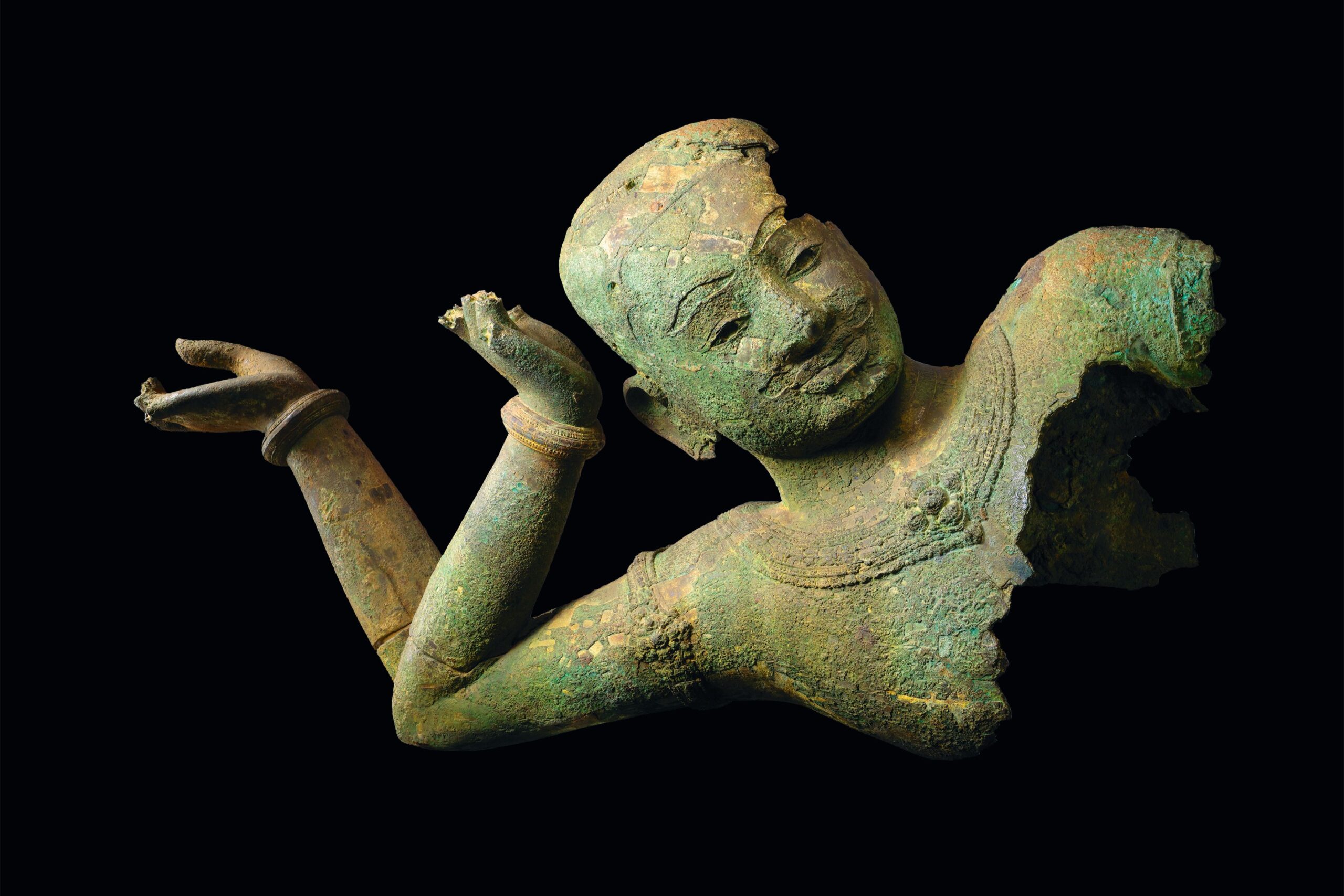
Teachers Guide: Royal Bronzes: Cambodian Art of the Divine
Introduction
Mia’s newest special exhibition, “Royal Bronzes: Cambodian Art of the Divine,” invites museum visitors to discover bronze artwork from the Khmer Empire, which ruled Cambodia and the surrounding lands for centuries. While many people know about Cambodia’s famous stone temples in Angkor, built to glorify kings who made themselves gods, this exhibition focuses on something less familiar: beautiful bronze artworks that have been hidden for centuries. Thanks to new discoveries and careful restoration, you and your students can now see them up close at Mia.
The exhibition is divided into five main sections: The Origins of Copper Metallurgy; Casting for the King; Honoring the Gods; New World, New Places, New Faith; and The West Mebon Vishnu: A Rebirth, a gallery dedicated to the study and recent reconstruction of a monumental sculpture unearthed in the Mebon temple complex.
Please use this guide to prepare your students for a visit to the exhibition or as a resource for leading discussions in the galleries. We have included discussion questions with each featured artwork to encourage close looking, critical thinking, and making connections.
We hope that you and your students will enjoy these rare Khmer bronzes at Mia and learn more about the powerful connections between royalty, religion, and art in Cambodia’s history. To request a guided or self-guided tour, simply complete our tour request form.
Spotlight on Cambodia
Cambodia is a country in Southeast Asia that shares borders with Thailand, Laos, and Vietnam. The Gulf of Thailand runs along the southwest coast. Central Cambodia is largely a low-lying plain; in the east, the Mekong River flows through hills and highlands.
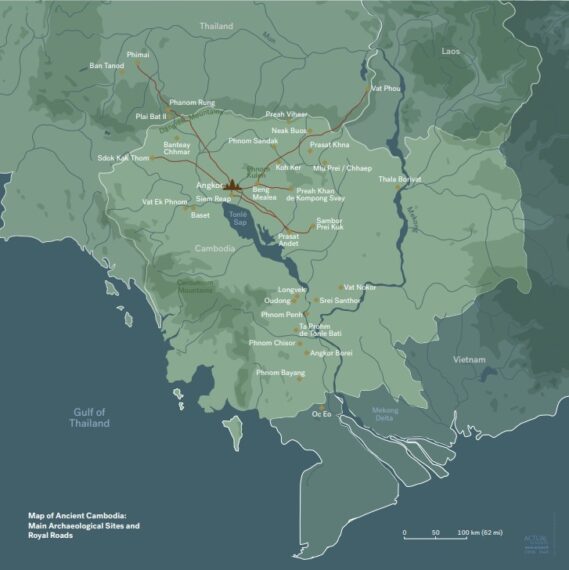
Most people in Cambodia (about 97%) are Khmer. Chinese, Vietnamese, and Cham people also live there. Buddhism is the main religion, but some people in rural areas also follow traditional beliefs. Around 80% of Cambodians live in the countryside.
The word Cambodia comes from the French word Cambodge, which is derived from the Khmer word Kâmpŭchéa. Kâmpŭchéa comes from an old Sanskrit name, Kambojadeśa, which means “land of Kamboja,” referring to people descended from a legendary Indian sage named Kambu. Europeans used the name Cambodia as early as 1524.
A Brief History of Cambodia
The Khmer Empire was one of Cambodia’s greatest ancient kingdoms and one of the most influential in Southeast Asia. Khmer kings, beginning with King Jayavarman II, ruled large parts of the region from the 800s through the 1200s. This empire helped spread Hinduism and Buddhism (adopted from India) across Southeast Asia and built many temples and complexes to honor not only the gods but also the kings who declared they were descended from the gods. At the height of its power during the 12th century, the empire constructed the magnificent temple complex of Angkor Wat, now a symbol of Cambodian national pride and a UNESCO World Heritage Site.

Preah Kahn. Photograph by Jaroslav Poncar. © Jaroslav Poncar
In 2007, researchers found that Angkor was the largest pre-industrial city in the world. It covered about 1,150 square kilometers and may have been home to up to one million people. After many wars, Angkor was abandoned after a final attack in 1432.
The Khmer Empire declined from the 1300s into the 1400s. Invasions by the Tai from what is now Thailand led to the loss of significant territory. In the 1800s, Cambodia’s sovereignty continued to weaken as both Thailand and Vietnam encroached upon its land and influence. In the late 1800s, Cambodia became a French protectorate. Colonized by France along with Laos and Vietnam, these Southeast Asian regions were collectively referred to as French Indochina. After being occupied by Japan during World War II, Cambodia gained independence in 1953 under King Norodom Sihanouk.
Great turmoil continued to harm Cambodia during the second half of the 20th century. During the Vietnam War (also called the American War) in the 1960s and 1970s, Cambodia suffered heavy damage from bombs as well as political instability. In 1975, the Khmer Rouge, a radical communist group led by Pol Pot, took power. In an attempt to create a classless, agrarian society, the Khmer Rouge forced millions into labor camps and executed people they considered enemies. An estimated 1.7 million Cambodians died
in what became known as the “Killing Fields.”
In 1978, Vietnamese-backed forces invaded Cambodia and overthrew the Khmer Rouge regime, establishing a new pro-Vietnamese government and renaming the country Kampuchea. Despite their defeat, Khmer Rouge forces continued guerrilla warfare for many years. Vietnamese troops withdrew in 1989, and by 1993, Cambodia had reestablished its monarchy and a new democratic government. That same year, the Khmer Rouge was officially banned. However, it wasn’t until Pol Pot’s death in 1998 that the movement truly ended.
Cambodia experienced relative stability and economic growth in the early part of this century and joined global trade and economic organizations. Political tensions and struggles for power, however, have continued to challenge the country’s development and democracy.
Cambodians in Minnesota
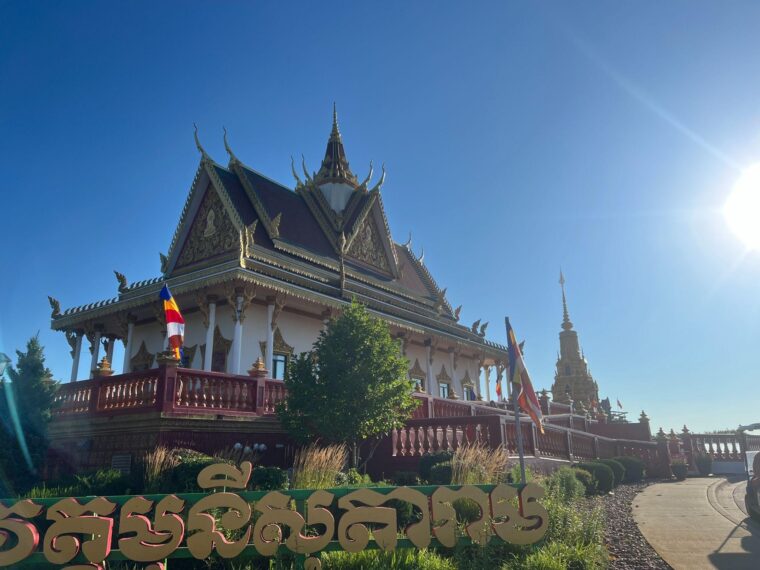
Watt Munisotaram, a Cambodian Buddhist temple in Hampton,
Minnesota. Photograph by Virajita Singh
Nearly 12,000 Cambodians live in Minnesota—one of the largest Cambodian populations in the United States. Many Cambodian immigrants arrived in Minnesota as refugees by way of Thailand in the 1980s, escaping the violence and genocide of the Khmer Rouge. Other Cambodians continue to immigrate here to be with their families and for work.
Watt Munisotaram, the largest Buddhist temple in North America, is in Hampton, Minnesota, about a 30-minute drive from the Twin Cities. Organizations like the Cambodian American Partnership of Minnesota (CAPMN) and MN8 support Cambodian communities throughout the state.
- Research the modern history of Cambodia and Cambodian immigration to the United States by looking at multiple sources or accounts. Identify different perspectives that you encounter.
- Research the story of Cambodian migration to Minnesota since the 1980s. Consider what kinds of primary sources could help you learn about their immigrant experiences.
Royal Bronzes: Cambodian Art of the Divine
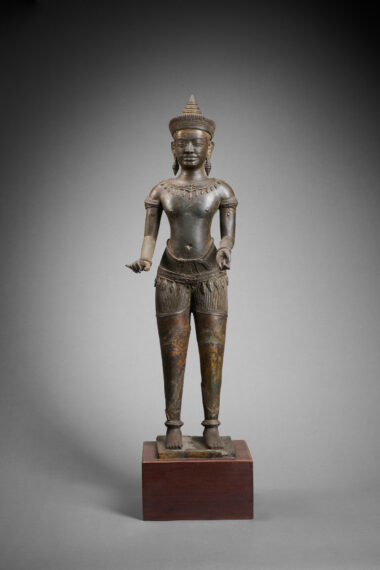
Cambodia, Takeo province, Kirivong district, Angkorian period, late 11th–early 12th century, bronze, mercury gilding. Phnom Penh, National Museum of Cambodia, mission by Henri Mauger (1936), Ga.2993 © Musée national du Cambodge, Phnom Penh / photo Thierry Ollivier / musée Guimet
An Introduction to the Exhibition
Angkor was the capital of the Khmer Empire from the 800s to the 1400s, and its world-famous stone temples and statues have taught us a lot about the empire’s religions and art styles. The bronze sculptures of gods and sacred objects add detail to our understanding of the times and how art was used.
Bronze—called samrit in Old Khmer—is made by melting copper and mixing it with other metals like tin and sometimes lead. In ancient Cambodia, metalworking was considered a sacred skill because people believed it was a gift from the gods. It was also associated with the Khmer kings who declared themselves “universal kings.”
Hinduism was the primary religion during the early Khmer Empire, inspiring the construction of significant temples such as the iconic Angkor Wat, which was dedicated to the Hindu god Vishnu. Special workshops near the royal palaces created bronze artwork to honor the Hindu gods, royalty, and, later, the Buddha and bodhisattvas. These workshops started in Angkor and later moved to other capitals like Longvek and Oudong (from the 1500s to 1800s) and eventually to Phnom Penh in the 1800s and 1900s.
Recently, archaeologists have uncovered more bronze artworks and used science to learn more and repair them. The huge bronze sculpture of the Hindu god Vishnu, highlighted in the exhibition’s final gallery, was carefully conserved after its excavation. These discoveries were made possible through teamwork between Cambodia’s Ministry of Culture, the Guimet National Museum of Asian Art in Paris, the French School of the Far East, and the Centre for Research and Restoration of French Museums.
The Origins of Copper Metallurgy
A long time ago, around 1100 to 1000 bce, people in early farming villages in Southeast Asia started digging copper out of the ground. They used it to make tools and small objects for everyday use. Sometimes they mixed copper with tin to create bronze, which is stronger and more durable. Until archaeologists working in Cambodia discovered bronze tools, weapons, jewelry, and even items used to make these objects, such as molds and crucibles (bowls used for melting metal), little was known about Khmer metallurgy.
When people in Southeast Asia started using iron, around 500 to 400 bce, metalsmiths reserved the use of bronze and copper for special personal and ritual objects. Over the next thousand years, metal artworks and objects became increasingly complex. Some ancient Cambodian cemeteries have revealed bells, bowls, jewelry, and mirrors made of various metals.
Even though many ancient sites were looted, experts believe there was a lot of large-scale metal production in Cambodia. Some of the earliest large bronze objects, like big bowls and bells, show amazing skill and suggest that making these took a lot of people as well as careful planning.
Today, a well-known Cambodian artist named Ith Sopheap, who often works for the Royal Palace, still uses the same techniques as those used by ancient Khmer artists. For this exhibition, he created a copy of an 8th-century statue of Maitreya, an important Buddhist figure, to help visitors understand the complex process of lost-wax casting. This process was used in Cambodia starting in the 6th century and is still used today.
The Eight Steps of Lost-Wax Casting:
- 1. Build the base: create a strong iron frame (like a skeleton for the statue).
- 2. Make the core: cover the frame with a mix of clay, sand, and rice husks.
- 3. Shape the statue in wax: add a detailed wax layer and small wax tubes to guide the bronze later.
- 4. Cover the wax with clay: use three layers of special clay mixtures to form a hard mold.
- 5. Bake the mold: heat it until the wax melts and drains out (this is where the “lost wax” happens).
- 6. Pour molten bronze into the mold, filling the cavity left by the melted wax.
- 7. Break open the mold: after the bronze cools inside, break it open to reveal the rough statue.
- 8. Finish the statue: clean, smooth, and polish it, then add final details.
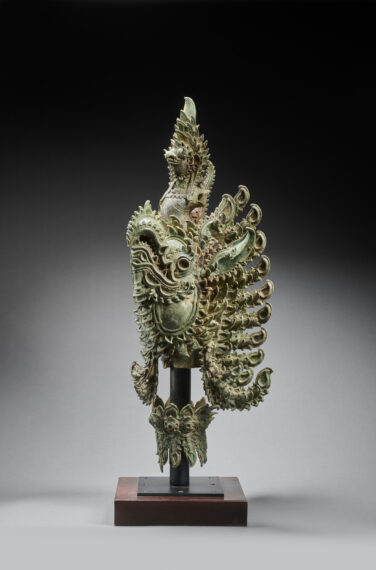
Exact provenance unknown (Cambodia, Preah Vihear province, Kulen district, possibly Phnom Sandak), Figurehead featuring Garuda, Angkorian period, end of the 12th to the beginning of the 13th century, bronze. National Museum of Cambodia, Phnom Penh, gift of Douglas Latchford, 2011, Ga.7319
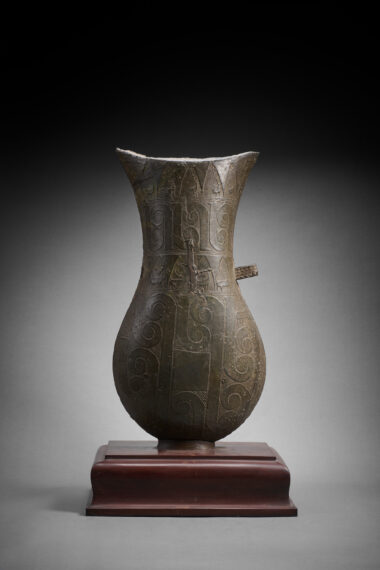
Cambodia, Phnom Penh municipality, Meanchey arrondissement, Chak Angre, Ritual Vessel, protohistoric period (400 bce–200 ce), high-tin bronze. Phnom Penh, National Museum of Cambodia, purchase (1948), Ga.2083 and Ga.3082 © Musée national du Cambodge, Phnom Penh / photo Thierry Ollivier / musée Guimet
Ritual Vessel, Protohistoric Period (400 BCE–200 CE)
This vessel is one of the first large bronze items found in Cambodia. Scholars are not exactly sure what its shape was based on, but one suggestion is a type of fisherman’s basket used throughout Southeast Asia. What it was used for also remains a mystery although some, like this one, have been called ritual vessels, urns, or flasks. This particular vessel is sometimes called the Kandal urn because of the Cambodian province where it was recovered in 1948.
The relatively few known vessels like this have come to light because farmers have uncovered them in their fields. Others have been discovered by treasure seekers using metal detectors! Like others of this type, this vessel features a round base and a waisted flask form. It has three small loop handles including one at the base and two on the sides just below the neck. These loops appear to have been added after the vessels were cast using the lost wax process.
The low-relief designs suggest the vessel might have been used in farming ceremonies to help bring good crops and fertile land. Animals and shapes associated with dry land and drought—triangles, deer, longnecked birds—are shown alongside symbols of water and rain, like spirals, men in boats, and elephants. Because these images lack a connection to Indian art, experts date them earlier than the 6th century CE, when bronze artworks throughout Southeast Asia began to reflect high Indian culture.
Look and Discuss
Look closely at this very old bronze (metal) artwork from Cambodia. What do you see? Look closely for the birds and animals!
What do the curving shapes remind you of? What kind of weather might these shapes remind you of? What about the shapes makes you think so? Why might artists living a long time ago want to put shapes and pictures related to water on a vessel?
Some people who study this kind of art think the shape of this vessel resembles baskets used by fishermen. Why do you suppose artists would choose to make a bronze vessel weighing about 23 pounds in this shape? If you were going to replicate the shape of something important to you or your culture in bronze, what would you choose? What makes it important?
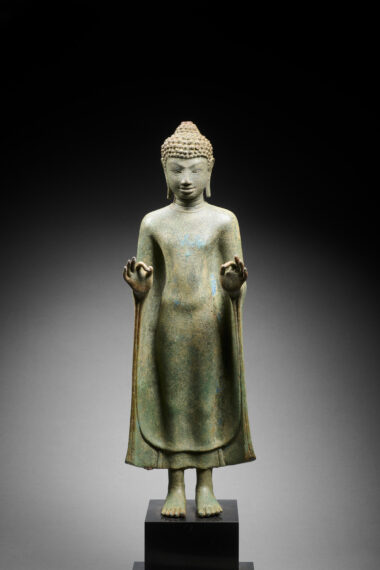
Exact provenance unknown, Cambodia or a neighboring country, The Buddha Making the Gesture (sk. Vitarkamudra) of Discussion with Both Hands, pre-Angkorian period, 7th–8th century, leaded brass. Phnom Penh, National Museum of Cambodia, restitution by Douglas Latchford (2023), © Musée national du Cambodge, Phnom Penh / photo Thierry Ollivier / musée Guimet
The Buddha Making the Gesture of Discussion with Both Hands, Pre-Angkorian Period, 7th–8th Century
In this early bronze Khmer sculpture, the Buddha wears very simple and symmetrical monk’s robes. Physical features that identify the figure as the Buddha include the extra bump on his head (called an ushnisha) that symbolizes his supreme knowledge, his long earlobes, and his snail-like curly hair—all of which relate to his story and communicate that he is a special individual.
The Buddha wears two layers of monastic robes that flow to just above his ankles. It appears as though the robes are very thin as the soft natural shapes of the torso, tummy, and legs are clearly shown. His face is also very natural, featuring expressive eyes, arching brows, and a slight smile. His hands are in a position associated with discussion, where the index finger touches the thumb.
Look and Discuss
The Buddha was a very important teacher. Look closely at this almost two-foot-high sculpture. What words would you use to describe the sculpture? What do you notice that tells you he is not an ordinary person?
The bump on his head is a symbol of his extraordinary knowledge. The long earlobes refer to a key part of his story where he gives up his princely wealth in search of solutions to suffering. Think about a person in history or today that is important to you. What special features would you include in a picture of them?
The Buddha’s hands are in a position that show he was interested in discussion and learning. What are some ways these ideals are illustrated in art, popular culture, and/or at school today? Why is the practice of discussion so important?
This bronze artwork was made before the Khmer Empire emerged as a superpower in Southeast Asia. After viewing other sculptures in this guide or in the exhibition, compare and contrast this Buddha figure to another figural sculpture. What do they have in common? How do they differ?
Casting for the King
During the Khmer empire, the kings adopted the Indian concept of chakravartin, which means “universal king” and describes a ruler with supreme authority over a vast territory and its diverse populations. King Jayavarman II, the founder of the Khmer empire, declared himself chakravartin in 802 CE, marking the beginning of the empire. This title connected him with powerful Hindu gods like Shiva and Vishnu. It gave them power over other rulers and aided the expansion of the empire. It also influenced the construction of monumental temples, the development of elaborate rituals, and the organization of Khmer society. This view of the kings as divine beings who derive their authority from their proximity to the gods, looking out for the well-being of their subjects, is central to the development of Khmer art, including the bronze artworks in this exhibition.
Ancient writings from Cambodia tell us that kings and high-ranking officials often commissioned bronze sculptures and other sacred objects from skilled artists. Although we know little about the individual artists, they held important positions in the royal court. By the 10th and 11th centuries (900s and 1000s), royal artists played a key role in strengthening the king’s image, using their artistic talents to express both his spiritual beliefs and political power through art. Artworks—frequently made from bronze, silver, or even gold—were gifted to temples as offerings to the gods.
In 2012, archaeologists discovered a royal foundry where bronze artworks and other objects were made at Angkor Thom, the ancient capital of the Khmer Empire in the 11th century (1000s). This foundry is one of the largest production centers for bronze art in the Khmer Empire. Excavations uncovered remains of tools, broken clay molds, and furnace fragments, which helped researchers develop a good picture of how ancient artists used sophisticated techniques to create the sculptures and decorations that once filled Khmer temples and royal spaces.
Honoring the Gods
Through trade and cultural contact with India, in the early centuries CE (Common Era), both Hinduism and Buddhism spread to Cambodia and other parts of Southeast Asia. Some people learned Sanskrit, an ancient Indian language, used for important writings and to communicate with the gods. By the 7th century (600s), sculptures of Hindu gods and Buddhist figures appeared, showing how important these religions and practices became in Khmer culture. Some of the oldest bronze statues found in Cambodia show Indian influence in their design and style. During the Angkor period (9th to 15th centuries, 800s to 1400s), Hinduism was the main religion, and Shiva was the most important god. Later, under King Suryavarman II, Vishnu became the main god. And then, under King Jayavarman VII, Buddhism became more popular and many people worshipped the Buddha.
The kings closely aligned themselves with Hindu and Buddhist stories to promote their own status. They commissioned artworks that would honor the gods, and, by extension, themselves. Artworks cast from metal, including bronze, often held the most important places in temples. Because the material is so valuable, many of these statues were later stolen, melted down, or repurposed to create new religious images.
The size and purpose of the sculptures varied. Large metal sculptures that aligned the kings’ special powers with the gods stood inside temples for use in daily worship. Medium-size statues were designed to be carried in religious festivals and processions. Individuals often kept smaller statues in their homes or brought them to temples as devotional offerings.
Even these smallest bronze figures were carefully made, with detailed features that helped worshippers recognize the figures they represented. The level of detail achievable with bronze casting made possible intricate designs that reflected both the spiritual devotion of the Khmer people and the artistic skill of the metalworkers who created them. In Buddhism, there’s a special image of Buddha sitting on a giant snake called the naga. This image shows the naga protecting Buddha during a storm. In Cambodia, this image became very popular during the Angkor period because of its association with the kings and protection. Artists often represented the Buddha sitting on the naga along with other important figures, like Lokeshvara (the bodhisattva of compassion) and Prajnaparamita (the goddess of wisdom).
Worship in temples was a big part of Cambodian life. People cleaned, dressed, and decorated the sculptures of gods with care. They offered food, flowers, music, and dances to show their respect. Temple ceremonies often featured items made of gold, silver, or copper. We know this because old lists tell us what objects were in the temples, including their materials and designs and even how much they weighed.
In the 12th and 13th centuries (1100s and 1200s), temples used a lot of metal for decoration. Artists and builders used bronze and copper to decorate temple walls, roofs, and doors. These decorations often copied the designs found in stone carvings, like flowers and religious symbols. Most of this metal is gone now, but scientists believe some temples used tons of metal to make them shine and inspire awe.
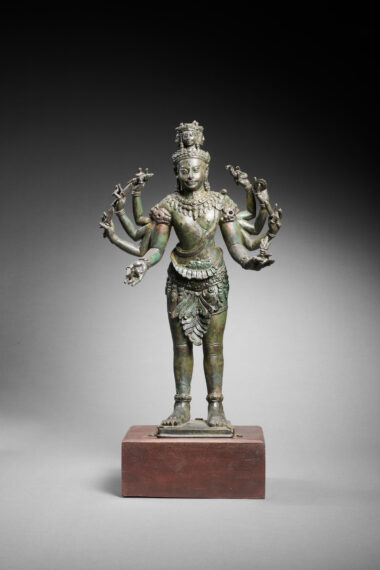
Cambodia, Siem Reap province, Puok district, Angkor, Prasat Yeay Moa, Shiva in The Form of Sadashiva or Bhairava, Angkorian period, 13th century, bronze. Phnom Penh, National Museum of Cambodia, contribution by Conservation d’Angkor (1970), Ga.2778 © Musée national du Cambodge, Phnom Penh / photo Thierry Ollivier / musée Guimet
Shiva in the Form of Sadashiva or Bhairava, Angkorian Period, 13th Century
The Khmer kings revered the powerful god Shiva, sometimes even identifying themselves as reincarnations of him. Shiva is a major deity in Hinduism because he embodies both destruction and transformation.
During the Angkorian period, sculptors showed Shiva in different forms. This very elaborate and fierce figure with multiple arms could represent Shiva in his most powerful and frightening form, Bhairava. Bhairava is the god of destruction and time, symbolizing death and transformation, the most important parts of the cycle of life.
The five heads on this Shiva suggest this could also show him in the form of Sadashiva, the most all-knowing of Shiva’s forms. His five heads stand for creation, protection, destruction, kindness (grace), and mystery. Together they emphasize Shiva’s destructive yet ultimately freeing nature, illustrating the natural order of the universe. The face at Shiva’s neck might also refer to the fifth head of Brahma, which Shiva cut off in a fit of anger.
Each of Shiva’s eight hands holds a symbol of his many powers. Some of the more common symbols in this sculpture include a flame that alludes to his powers of destruction and rebirth, a sword illustrating his power to cut through ignorance, and the snake (naga), which in Khmer art holds multiple meanings including power and compassion. The objects shown in Shiva sculptures vary depending on the specific form(s) represented and the contexts for which they are made.
Look and Discuss
Take a long look at this bronze sculpture of the Hindu god Shiva. There is so much to see! What do you notice first? What about that caught your attention? Look for a small flame, multiple heads, skulls, and two snakes.
The artists who made this sculpture had to have a lot of knowledge about Shiva and his many forms. What do you know a lot about? How might you use everything you know about your favorite subjects to create a fantastic sculpture? What would it look like? What kind of hidden meanings might you include so that only other people with your special knowledge would understand them?
Showing a god with eight arms is a very clear way to show that he is powerful. Think about other gods from around the world. What features do writers and visual artists include to show these gods’ special powers?
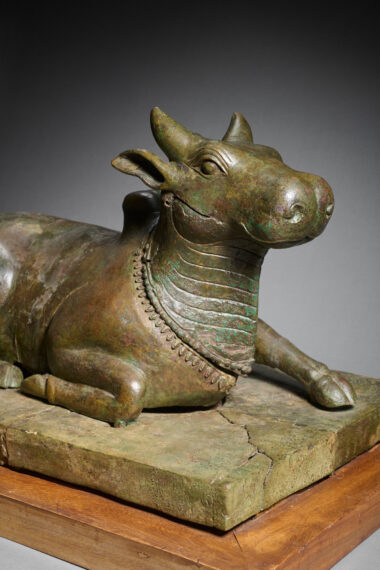
Cambodia, Siem Reap province and district, Angkor, West of Angkor Wat, Shiva’s Bull, Angkorian period, 12th–13th century, head and body: bronze, mercury gilding; base: leaded bronze. Phnom Penh, National Museum of Cambodia, contribution by Conservation d’Angkor (1970), Ga.5739 © Musée national du Cambodge, Phnom Penh / photo Thierry Ollivier / musée Guimet
Shiva’s Bull, Angkorian Period, 12th–13th Century
This bull sculpture, found buried at the Angkor Wat temple with two Chinese ceramics in 1968, was likely part of a ritual or ceremony. In Hinduism, the bull Nandin is associated with Shiva as his mount (the animal on which he rode around) as well as his animal form. As such, bull sculptures are often placed in front of Cambodian temples dedicated to Shiva, based on an Indian tradition. The inscription on the base of this sculpture tells us that the sculpture was likely donated by the daughter of a guru for an unnamed king. Scholars believe this bull dates to the 12th century (1100s) or later.
The details on the bull statue reveal a great deal of naturalism. The modeling of the ears, horns, eyes, and nostrils suggest that the sculptor took care to represent the bull respectfully and as it would appear in the real world. Nandin wears a necklace with bells, signifying his role as Shiva’s companion and vehicle.
The sculpture comprises six pieces that were separately cast and then assembled with tenons and pins. The head was attached to the body, which was connected to the base that was cast in four parts, including the left hind leg. If you look closely at Nandin you can see slight variations in color on the various parts.
Look and Discuss
This bronze sculpture shows Nandin the bull, a very special animal in Cambodian art. What do you see that tells you the bull is important? Which parts of the bull look most real?
Bulls hold a special place in Khmer art because of their close association with the Hindu god Shiva. Nandin the bull is Shiva’s mount, meaning he transported Shiva from place to place. Shiva can also take the form of a bull. Think about stories from the past and present and from around the globe that include special animals associated with the most important characters. Together, make a list of these special animals.
The artists who made this sculpture of Nandin the bull made six different pieces and put them together. Based on close observation, where do you see the different parts coming together? What did you notice that helped you figure out this puzzle?
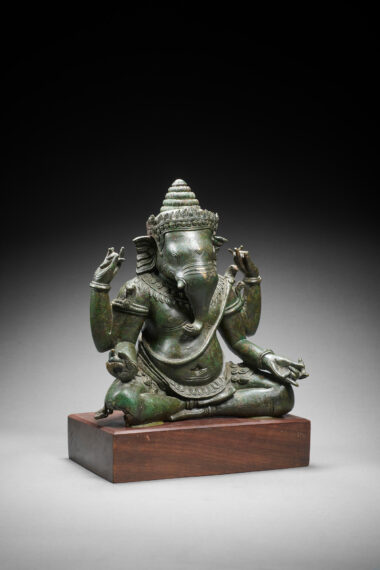
Cambodia, Siem Reap province, Puok district, Angkor, Prasat Yeay Moa, Ganesha, Angkorian period, 13th century, copper-based alloy. Phnom Penh, National Museum of Cambodia, contribution by the Musée Guimet (1996), Ga.5987 © Musée national du Cambodge, Phnom Penh / photo Thierry Ollivier / musée Guimet
Ganesha, Angkorian Period, 13th Century
This large statue shows Ganesha, the elephant-headed god and son of Shiva and Parvati (or possibly of Parvati alone), sitting cross-legged like a yogi—someone who practices yoga and meditation. He has four arms and wears a lot of decorations, including a necklace, crown, and armbands with cobras. In his upper right hand, Ganesha holds his broken tusk, which he once threw at the moon in anger. In his lower left hand, he holds an axe symbolic of his ability to break through obstacles (in the path of attaining knowledge). Ganesha has remained a very popular figure across many centuries because of his ability to defeat all obstacles. The other two objects he holds may be a Khmer version of modakas, the elephant-god’s favorite sweet treats.
This Bayon-style Ganesha was discovered in May 1966 when workers were extending the runway of the Siem Reap airport. Old photos from 1966 show that the sculpture originally sat on a symmetrical base, which was already in pieces when it was found.
According to Ganesha’s story, Parvati created him from clay while Shiva was away. After creating Ganesha, she decided to bathe and ordered him to guard the entrance to the house. Shiva came home and demanded to be let in, but because Ganesha did not know Shiva, he refused to let him in! Ultimately, not realizing that Ganesha was his son, Shiva beheaded him. When Parvati ordered Shiva to replace their son’s head, he found an elephant’s head to be used as a replacement.
Look and Discuss
What parts of this sculpture look like an elephant? Which parts look like a human? Make lists of the elephant and human features that you see. What else do you notice that is neither elephant or human?
Across time and geography, characters blending human and animal features have captured our imagination. Who are some characters with animal and human features that you like the best? Why?
If you were asked to make an artwork of a special being that could remove all obstacles in peoples’ lives today, what would your character’s story be? What would they look like?
Compare and contrast this sculpture of Ganesha with the sculpture of Shiva in this guide, made during the same time period. How are they different? What aspects of both sculptures might tell you that they are made during the same time period?
Think about making a ten-inch sculpture out of bronze. Based on what you learned about bronze casting, what are some of the many things you would have to think about to make this sculpture?
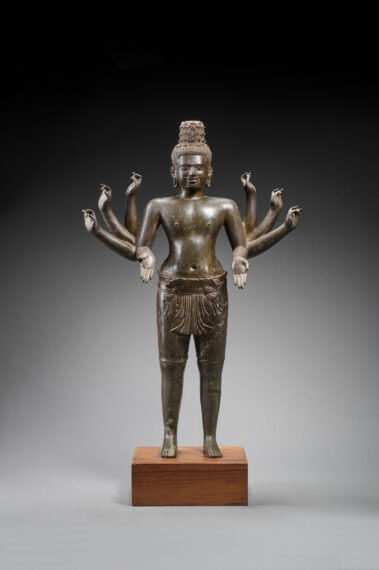
Cambodia, Kampong Chhnang province, Kampong Tralach district,
Buddhist monastery of Vat Ampil Teuk, Maitreya, Angkorian period,
early 10th century, high-tin bronze, silver, glass, stone. Phnom Penh,
National Museum of Cambodia, contribution by the Royal Library
(1926), Ga.2024 © Musée national du Cambodge, Phnom Penh / photo Thierry Ollivier / musée Guimet
Maitreya, Angkorian Period, Early 10th Century
This sculpture depicts the bodhisattva Maitreya, the future Buddha. When the original Shakyamuni Buddha’s teachings are forgotten, Maitreya will be born in this world to rediscover the same truths as the Buddha.
We can tell it is Maitreya because of the small stupa, a type of sacred building, placed on his headdress. This artwork was created around the early 10th century in Cambodia, during the beginning of the Angkorian period, when Tantric Buddhism, a more complex form of Buddhism, was practiced. Very few Buddhist images were commissioned then and almost no bronzes survive from this time, so this is a very rare sculpture.
Maitreya’s hairdo appears as layers or tiers of looped hair. The little stupa pays homage to Maitreya’s predecessor, the Buddha Shakyamuni, whose teachings became the practice of Buddhism. The design of small pearls at the end of each hair loop comes from an earlier tradition of bronze sculptures of bodhisattvas (kind and generous helpers in Buddhism) in northeastern Thailand. Maitreya’s face features a beard and moustache. His hair style and horizontal eyebrows stylistically connect him to stone sculptures of the period, suggesting a shared idea of how gods should be represented.
The garment worn by Maitreya also connects this sculpture to stone images of male divinities from this time period. The basic garment is a long piece of cloth wrapped around the waist. A folded end of the cloth goes through his legs and tucks into the back. Here, an extra layer of cloth, perhaps a scarf, is tucked into Maitreya’s belt.
Maitreya’s upper hands symmetrically perform the gesture of giving. His lowered hands might be a reference to offering compassion. The representation of Maitreya as having eight arms appears to be a Cambodian invention, given that no Indian prototype exists. It seems likely that the artist is referencing the eight arms of Avalokiteshvara, another bodhisattva who is regularly shown with Maitreya and the Buddha, and who can also give compassion to those in need.
Look and Discuss
Take time to look closely at the details in this bronze sculpture of Maitreya. What do you see? Look for a small building (a stupa) on his head, a thin moustache, and small pearl-like shapes in his hair.
Do you think Maitreya looks real or made-up? What do you see that makes you say so? Why do you think an artist might want to include realistic features alongside more fantastic features like Maitreya’s eight arms?
It’s common practice to show Buddhist and Hindu figures with multiple arms and even multiple heads. Think about images of people you admire today. How do visual images and media show that they are extraordinary? What features would you include in an artwork about yourself to illustrate your superpowers?
Compare and contrast this sculpture of the future Buddha with the first Buddha sculpture in the guide. What do they have in common? What are the most striking differences?
How does the Maitreya sculpture show how more sophisticated bronze casting became over a couple of centuries? Think about the impact royal patronage had on the advancement of bronzemaking technology.
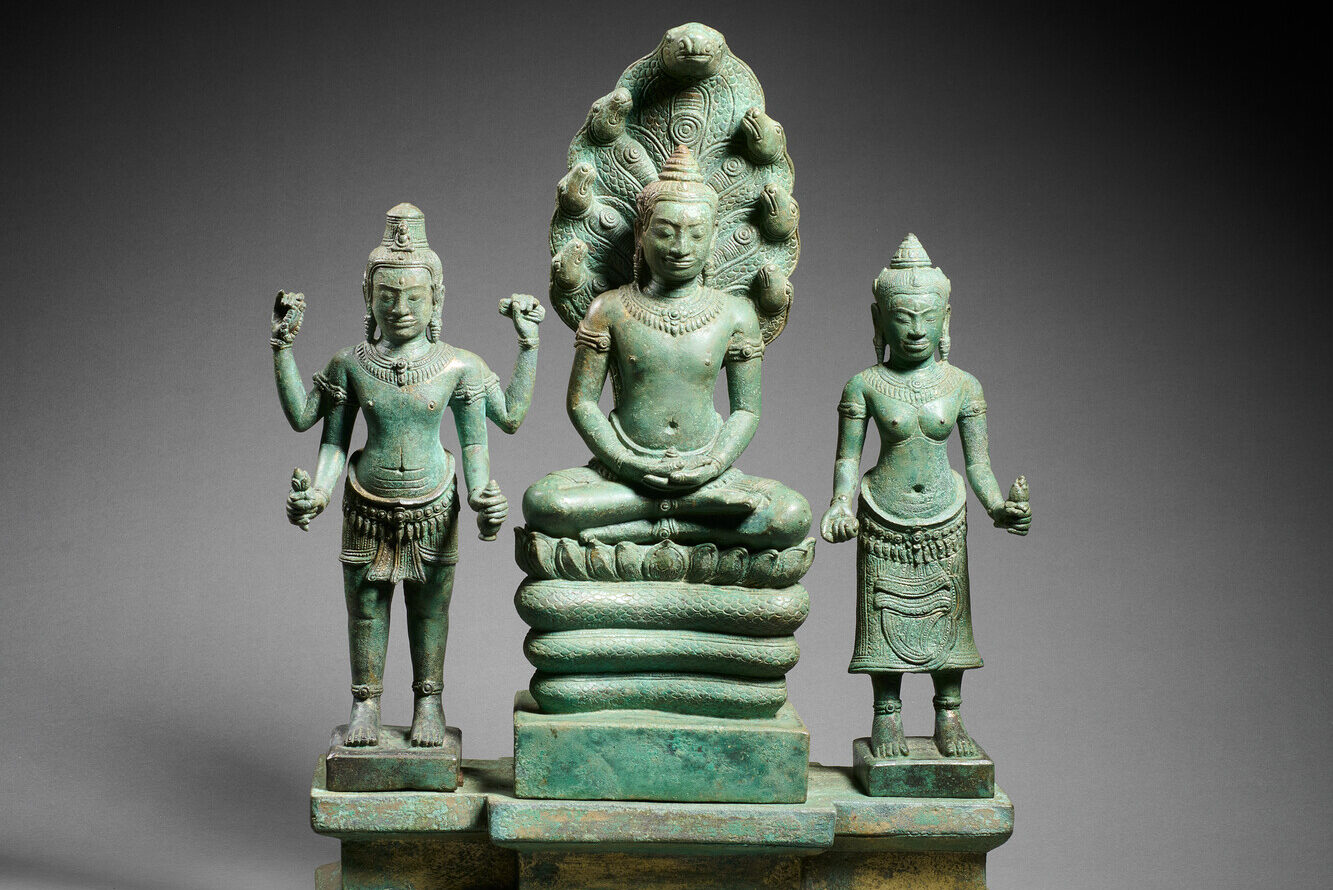
Cambodia, Siem Reap province, Prasat Bakong district, Roluos, Veal Kralanh, Buddhist Triad: The Buddha Enthroned on the Naga, Surrounded by Lokeshvara and Prajnaparamita, Angkorian period,
late 12th to early 13th century, bronze, mercury gilding. Phnom Penh, National Museum of Cambodia, contribution by Conservation d’Angkor (1970), Ga.2424 © Musée national du Cambodge, Phnom Penh / photo Thierry Ollivier / musée Guimet
Buddhist Triad: The Buddha Enthroned on the Naga, Surrounded by Lokeshvara and Prajnaparamita, Angkorian Period, Late 12th to Early 13th Century
When Jayavarman VII (r. 1182/1183–c. 1220) took power, the chief religious image became the Buddha protected by a serpent, called the naga. This type of image entered Cambodian art earlier in the 10th century. The Buddha’s story includes a passage in which the serpent Mucalinda protects him from a storm following his enlightenment.
This alone does not explain the prevalence of the image. The most likely connection in Cambodia is that the serpent is the spirit of irrigating waters. Railings in the form of serpents in some Angkor temples depict the serpents as bridges to heaven, suggesting yet another interpretation.
The kings connected their own stories and images as protectors to those of the Buddha. Khmer Buddhist imagery like this sculpture also emphasizes a triad of figures consisting of the Buddha enthroned on the naga, the bodhisattva Lokeshvara, who symbolizes compassion, and the goddess Prajnaparamita, representing wisdom.
Scholars of Khmer sculpture consider this work, discovered in 1962, the finest example of this type. Next to the seated Buddha, Lokeshvara stands holding his characteristic attributes: the lotus flower, rosary, manuscript, and water vessel. Prajnaparamita also stands and holds a lotus flower and a manuscript, the Prajnaparamita Sutra, a fundamental text in the teachings of Buddhism. The naga is rendered in incredible detail, with hundreds of scales covering its coiled body and stretched-out necks. The naga’s top head flares out like that of a cobra, providing protection to the Buddha.
Cambodian art of the period also features fleshier and more naturalistic facial features. This style likely developed out of the king’s desire to make sure that his face was closely associated with power and divinity. This naturalism is particularly visible in this sculpture in the modeling of the faces, each suggesting an element of portraiture. Cambodian art experts have pointed out that the face of the
Buddha in this sculpture, as well as features seen in the Lokeshvara, are a lot like known images of King Jayavarman VII. This could suggest that sculptors created a new style under the leadership of this king who made Buddhism the main religion during his reign.
Look and Discuss
There is a lot to see in this bronze sculpture. Starting with the figure in the middle make a list of what you notice about each one. In what ways are they alike? How are they different?
The image in the middle shows the Buddha, a well-known teacher and leader who lived centuries earlier. The artist shows him sitting on a very large snake or serpent, called the naga. Describe the naga—what is it doing? Why might kings who want to show themselves as protectors of their people show the naga like this? What are some things the artist did to show great respect for the naga (and the king)?
King Jayavarmin VII wanted people to know his name and what he looked like. The face of the Buddha in this sculpture looks a lot like portrait sculptures of the king made during this period including one in the exhibition at Mia. This king was not alone in wanting his face to be well known. What other royal or leader faces are familiar to you because they have been shown in art and other media over and over again?
New World, New Places, New Faith
After the fall of the great Angkor Empire in the 1400s, Cambodia went through a long period of change. Cambodia’s capital shifted south, and foreign trade reshaped its culture. This post-Angkorian period lasted from 1431 to 1863. During these centuries, Cambodia was no longer as powerful as it had been during the Khmer Empire, but it remained an important part of the region.
At the same time, new global trade networks were growing. Large and powerful empires such as China, Portugal, the Netherlands, and India were exploring new lands, making trade connections, and bringing with them new ideas, technologies, and religions. Cambodia was caught between adopting the influences of foreign cultures and its deep connection to the glory of its ancient kings and religious traditions.
In the 15th century, the powerful Siamese kingdom of Ayutthaya (in what is now Thailand) invaded and captured the city of Angkor. After this loss, the Cambodian royal family and court moved south of the Tonle Sap Lake. Over time, they moved to different places. In 1865, after Cambodia became part of the French protectorate, King Norodom I made Phnom Penh the capital city.
Theravada Buddhism became the main religion in Cambodia, replacing the earlier forms of Hinduism and Mahayana Buddhism. This branch of Buddhism focused more on personal spiritual practice and less on large temples or numerous gods. Even though Cambodia was no longer an empire, religion remained very important, and so did the use of metal sculptures. Images of the Buddha, Hindu gods, and even royal ancestors continued to be made from bronze and other metals. The fact that metalwork remained so important for over 400 years shows how strong and lasting Khmer traditions were.
The West Mebon Vishnu: A Rebirth
In December 1936, Maurice Glaize, a French archaeologist working in Angkor, reported a surprising event. A local man named Chhit-Lat, from a nearby village, said he had a dream in which the Buddha told him to free a buried figure that was trapped under the earth and stones. He went to the West Mebon temple and dug about three feet into the ground and uncovered part of a huge bronze statue—the head, shoulder, and hand.
When experts from the French School of Asian Studies arrived, they saw it was a major discovery: the upper part of a massive bronze sculpture of the Hindu god Vishnu, shown lying down. This pose is common in Khmer art and has deep meaning. It shows Vishnu asleep on a giant serpent named Ananta, after the universe has been destroyed. When Vishnu wakes up, a lotus grows from his body and the god Brahma appears from the flower to create a new world.
This statue, now usually displayed in the National Museum of Cambodia, is considered a masterpiece of ancient Khmer bronze art. Its restoration was made possible through a partnership between the National Museum, the French School of Asian Studies, a French museum conservation center (C2RMF), and The Guimet Museum. Before being restored in a lab in Nantes, the statue was carefully studied by scientists.
Now, for the first time, it’s being shown together with important pieces found with it, offering the most complete view yet of the reclining Vishnu from the West Mebon temple. It is a focal point of this exhibition, taking up the entire final gallery!
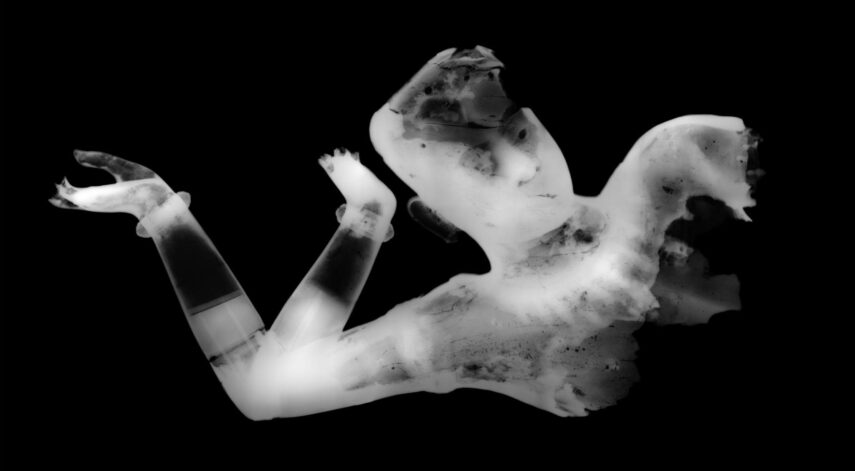
Gamma radiography of the Vishnu bust, National Museum of Cambodia, Phnom Penh, Ga.5387
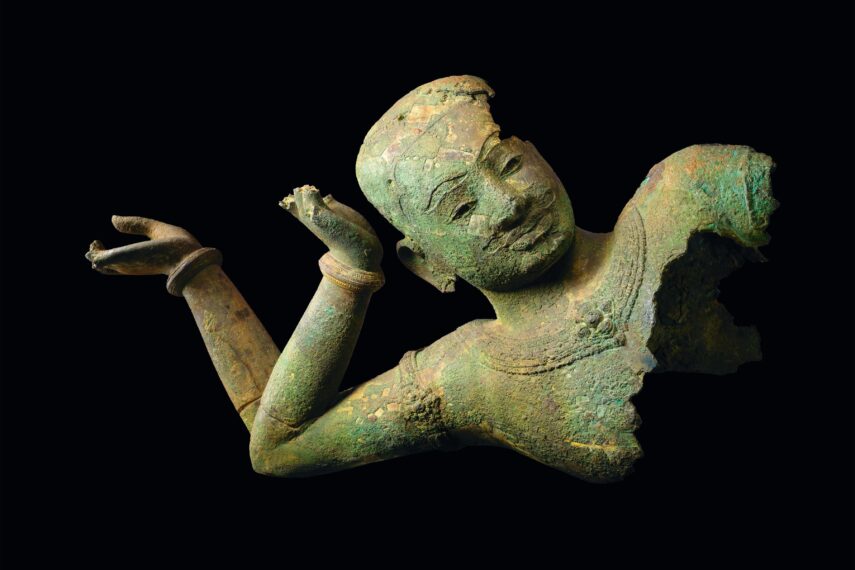
Cambodia, Siem Reap province, Puok district, Angkor, West Mebon, Bust of Anantashayin Vishnu, Angkorian period, second half of the 11th century, bronze, mercury gilding, silver, lead, cinnabar. Phnom Penh, National Museum of Cambodia, Ga.5387 © Musée national du Cambodge, Phnom Penh / photo Thierry Ollivier / musée Guimet
Bust of Anantashayin Vishnu, Angkorian Period, Second Half of the 11th Century
This monumental bronze sculpture of Vishnu reclining is a testament to the skill of Khmer artists. When fragments of this statue were found in 1936 during excavations of a platform at the Western Mebon temple in Angkor, they were brought to the National Museum of Cambodia late in 1950.
This sculpture represents Vishnu reclining in cosmic sleep on top of the serpent Ananta, who was floating on the ocean. It was made to sit in a vast reservoir at Angkor constructed by King Udayadityavarman II (r. 1050–1066) to represent the ocean. In the Vishnuite creation story, when the Vishnu reclined on the serpent on the ocean, a lotus plant sprang from his navel. In this lotus was Brahma, who set the cycle of creation in motion.
Vishnu is the preserver of the world. The king had the huge sculpture created to safeguard the city of Angkor. Vishnu’s facial expression and the way his head rests on one of his four hands show that he is looking out over the city. He wears decorative armbands, bracelets and a round collar that features a large rosette in the center and pendants at the back. The hollows of the eyes, brows, and moustache show where the ancient Khmer artists added color, perhaps by inlaying precious stones and metals. Holes in the head also suggest that he once wore a detachable gold diadem.
What we can no longer see is that the colossal sculpture, which is now green, was originally covered in gold. Because the makers applied the gold with mercury, it quickly disappeared when the earth covered the sculpture. The final gallery in the exhibition lets visitors imagine what it might have looked like when first made.
Over several years, experts used advanced tools to study and protect the bronze sculpture. They used techniques like digital modeling and special imaging to check the condition of each piece, figure out how the parts might have originally fit together, and stop any further damage. The careful work included strengthening the structure, gently cleaning it to show more detail, and creating a new support system that keeps the Vishnu sculpture safe while staying true to its original shape.
Look and Discuss
This sculpture is four feet tall and over seven feet long. And it is only a small part of a much larger sculpture showing the god Vishnu lying down. What do you notice about the sculpture? What does it make you wonder?
Use your imagination to think about what this sculpture would have looked like when it was made a long time ago, fully covered in gold! Imagine that his face was colorful.
Many creation stories involve water. Why do you suppose this is so? Think of a well-known creation story–how might you illustrate that story? What materials or techniques would you use? Who would you want to see your artwork? Why?
The reconstruction of parts of this sculpture and images made to illustrate what it likely looked like long ago are only possible because of the study and work of many scientists and other experts as well as constantly evolving tools and techniques. What are some technologies being used today to solve problems? What technology do you use today to help you understand the past? To draw? To make 3-D figures? To solve problems?
Minnesota State Standards in Social Studies and Visual Arts
Consider connecting classroom study and an in-person visit to the exhibition “Royal Bronzes: Cambodian Art of the Divine” to several of the Minnesota state anchor standards in history, ethnic studies, and geography, depending on the grades you teach.
History
• Change, Continuity, and Context: Ask historical questions about context, change, and continuity in order to identify and analyze dominant and nondominant narratives about the past.
• Historical Perspectives: Identify diverse points of view and describe how one’s frame of reference influences historical perspective.
• Historical Sources and Evidence: Investigate a variety of historical sources by a) analyzing primary and secondary sources, b) identifying perspectives and narratives that are absent from the available sources, and c) interpreting the historical context, intended audience, purpose, and author’s point of view of these sources.
Ethnic Studies
• Identity: Analyze the ways power and language construct the social identities of race, religion, geography, ethnicity, and gender. Apply these understandings to one’s own social identities and those of other groups living in Minnesota, centering those whose stories and histories have been marginalized, erased, or ignored.
Geography
• Places and Regions: Describe places and regions, explaining how they are influenced by power structures.
• Human Systems: Analyze patterns of movement and interconnectedness within and between cultural, economic, and political systems on a local to global scale.
• Culture: Investigate how sense of place is impacted by different cultural perspectives.
• Causation and Argumentation: Integrate evidence from multiple historical sources and interpretations into a reasoned argument or compelling narrative about the past.
Visual Arts
• Analyze and construct interpretations of artistic work.
• Integrate knowledge and personal experiences while responding to, creating, and presenting artistic work.
• Demonstrate an understanding that artistic works influence and are influenced by personal, societal, cultural, and historical contexts, including the contributions of Minnesota American Indian tribes and communities.
• Evaluate artistic work by applying criteria.

